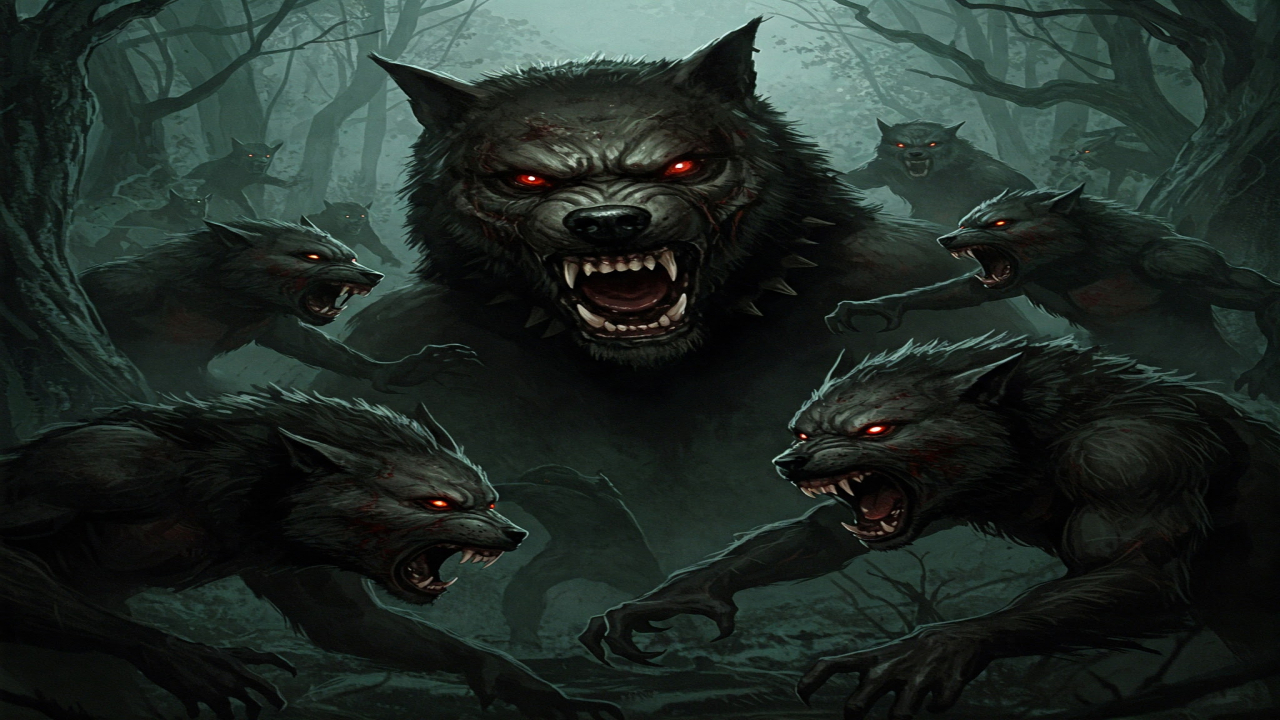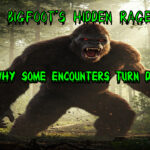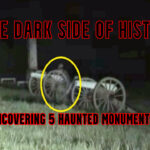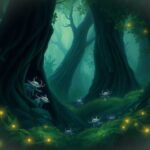
Here’s a breakdown of the key differences between werewolves and dogmen:
Transformation:
Werewolves: Typically, humans who transform into wolf-like creatures, often involuntarily (triggered by the full moon, a curse, etc.). They may retain some human-like intelligence and even speak.
Dogmen: Primarily depicted as a distinct species, not humans who transform. They are always in a bipedal, dog-like form.
Origin:
Werewolves: Deeply rooted in European folklore, with a long history in mythology and literature.
Dogmen: A more recent phenomenon, primarily associated with North American folklore and cryptid sightings.
Physical Appearance:
Werewolves: Often depicted as large, muscular wolves with some human-like features (like hands). Their appearance can vary greatly depending on the specific folklore.
Dogmen: Described as bipedal creatures with dog-like heads, long limbs, and shaggy fur. They are often taller and more robust than typical wolves.
Behavior:
Werewolves: Behavior can vary greatly depending on the specific lore. Some are violent and predatory, while others are more tragic figures struggling with their transformation.
Dogmen: Generally depicted as wild and potentially dangerous creatures, often associated with sightings in remote or forested areas.
In Summary:
Werewolves are typically human-to-wolf transformations, while Dogmen are a separate, distinct creature.
Werewolves have a much longer and more established presence in folklore and literature.
Their physical appearances and behaviors also exhibit key differences.
Anubis, the ancient Egyptian god of death, mummification, and the afterlife, is most commonly depicted with the head of a jackal or a dog-like creature. Here’s a breakdown of his dog-like features:
Jackal/Dog Head: This is his most prominent feature. While often called a “jackal,” some scholars believe the depiction may be closer to a wild dog or a specific breed of dog that existed in ancient Egypt.
Ears: Anubis typically has large, pointed ears, similar to those of a jackal or a dog.
Snout: He has a long, narrow snout, characteristic of canine species.
Coloration: Anubis is often depicted as black. Black was associated with regeneration, life, and the fertile soil of the Nile in Egyptian culture, and it also symbolized the discoloration of the corpse after embalming.
Why the Dog-like Appearance?
Jackals and dogs were often seen near cemeteries in ancient Egypt as scavengers. This association with death and the underworld likely contributed to Anubis’s canine appearance.
Anubis’s Role:
Mummification: Anubis was believed to have invented the process of mummification, ensuring the preservation of the body for the afterlife.
Weighing of the Heart: In the afterlife, Anubis presided over the “Weighing of the Heart” ceremony, where the deceased’s heart was weighed against the feather of Maat, the goddess of truth and justice.
Guide to the Underworld: He was the guide who led the deceased through the perilous journey to the afterlife.
The Dogman cryptid and Anubis, the Egyptian god, share some intriguing parallels:
Canine Form: Both are depicted with canine features, though Anubis has a more pronounced jackal/dog head, while Dogman is described as a bipedal humanoid with canine characteristics.
Wildness/Mystery:
Anubis is associated with the wild, untamed desert and the mysteries of the afterlife.
Dogman is an elusive creature of the wild, often reported in remote or forested areas, adding to its mystique and air of the unknown.
Potential for Fear:
While Anubis was not inherently malevolent, his association with death could evoke a sense of awe or even fear.
Dogman is often described as a frightening creature, with reports of aggressive behavior and unsettling encounters.
Connecting the two:
Some might draw connections between the two through the concept of the unknown and the fear of the wild. Both represent something beyond human understanding, something that exists on the edges of our perception.
there is a significant instance of transformation into a wolf-like creature in the Epic of Gilgamesh.
Ishtar’s Rejected Suitor: The story tells of a young shepherd who dedicated himself to the goddess Ishtar. Ishtar, initially flattered, eventually grew tired of his devotion and, as an act of spite, transformed him into a wolf.
Significance: This episode is crucial for two reasons:
Gilgamesh’s Rejection of Ishtar: Gilgamesh witnesses this transformation and learns of Ishtar’s capricious and destructive nature. This knowledge plays a significant role in his decision to reject Ishtar’s advances, fearing a similar fate.
Early Depiction of Transformation: This episode provides one of the earliest known literary depictions of a human-to-wolf transformation, predating many other well-known werewolf tales in European folklore.
Reports of dog-headed races can also be traced back to Greek antiquity. In the fifth century BC, the Greek physician Ctesias, in his Indica, wrote a detailed report on the existence of cynocephali in India. Similarly, the Greek traveler Megasthenes claimed to know about dog-headed people in India who lived in the mountains, communicated through barking, wore the skins of wild animals and lived by hunting. Claudius Aelianus also mentioned the dog-headed tribes in India, and he, too, wrote that they are of human shape and clothed in the skins of beasts. He also added that although they have no speech and howled to communicate, they were capable of understanding the Indian language
Ibn Battuta encountered what were described as “dog-mouthed” people on his journey.
Fifteen days after leaving Sunaridwan we reached the country of the Barahnakar, whose mouths are like those of dogs. This tribe is a rabble, professing neither the religion of the Hindus nor any other. They live in reed huts roofed with grasses on the seashore, and have abundant banana, areca, and betel trees. Their men are shaped like us, except that their mouths are shaped like those of dogs; this is not the case with their womenfolk, however, who are endowed with surpassing beauty. Their men too go unclothed, not even hiding their nakedness, except occasionally for an ornamental pouch of reeds suspended from their waist. The women wear aprons of leaves of trees. With them reside a number of Muslims from Bengal and Sumatra, who occupy a separate quarter. The natives do all their trafficking with the merchants on the shore, and bring them water on elephants, because the water is at some distance from the coast and they will not let the merchants go to draw it for themselves, fearing for their women because they make advances to well-formed men.
— Ibn Battuta
Native American Legends: Some believe the Beast’s origins lie in Native American folklore, perhaps a shape-shifting spirit or a guardian of the ancient forests.
Cursed Settler: Another theory suggests the Beast is a cursed settler from the early days of the region, driven mad by isolation and transformed into a monstrous creature.
Shapeshifting: Many Indigenous cultures feature stories of shapeshifting animals, including wolves, coyotes, and other canids. These creatures might transform into humans or other beings, sometimes with unpredictable or even dangerous consequences.
Skinwalkers: In some Navajo and other Indigenous traditions, “Skinwalkers” are powerful witches who can transform into animals, often with malevolent intent. While not always canine, these shapeshifters often embody fear and the unknown.
Trickster Figures: Coyote is a common trickster figure in many Indigenous mythologies. While not always black, Coyote is often associated with mischief, cunning, and sometimes even chaos. These stories might feature Coyote exhibiting unusual or unexpected behaviors, perhaps with a hint of the uncanny.
Ancient Roots:
Werewolf myths have deep roots in European history, with connections to ancient Greek and Roman mythology.
The Greek myth of King Lycaon, who was transformed into a wolf by Zeus as punishment, is a notable example.
Medieval and Early Modern Europe:
During the Middle Ages, werewolf hysteria flourished.
Numerous individuals were accused of lycanthropy (werewolfism) and subjected to brutal trials and executions.
The “Beast of Gevaudan,” a creature that terrorized a region in 18th-century France, fueled speculation and fear about werewolves.
Folklore and Literature:
Werewolves became prominent figures in folklore and literature throughout Europe.
Stories varied across regions, but common themes included:
Transformation: Often triggered by a curse, a bite, or the influence of the full moon.
Violence: Werewolves were often depicted as savage predators, attacking livestock and sometimes humans.
Tragedy: Some tales portrayed werewolves as tragic figures, struggling with their uncontrollable transformations.
Modern Influence:
Werewolves continue to be popular figures in modern media, from classic literature (like “The Werewolf of Paris” by Guy Endore) to contemporary movies and television shows.
The Beast of Bray Road is a cryptid, a wolf-like creature reported to have been sighted in or near Elkhorn, Walworth County, Wisconsin.
Here are some of the stories and reported sightings associated with the Beast of Bray Road:
Early Sightings:
While some accounts suggest earlier sightings, the modern wave of reports began in the 1980s.
One of the earliest well-known accounts comes from Lori Endrizzi, who in 1989 reported seeing a large, wolf-like creature standing upright by the roadside.
Increased Activity in the 1990s:
The 1990s saw a surge in reported sightings.
Accounts included:
A high school student, Tom Brichta, reporting a collision with the creature.
Numerous reports of the creature leaving scratch marks on vehicles.
Sightings of the creature walking upright, running on all fours, and even scavenging for food.
Continuing Interest:
The Beast of Bray Road continues to be a subject of local folklore and occasional news stories.
It has been featured in documentaries, books, and even a horror film.
The “Beast of the Land Between the Lakes” is a cryptid reported to inhabit the Land Between the Lakes National Recreation Area, a region situated between Kentucky Lake and Lake Barkley in western Kentucky and Tennessee.
Here’s what’s typically reported about this creature:
Appearance:
Described as a bipedal wolf-like creature, standing around 7 feet tall.
Often reported to have clawed hands, powerful jaws with wicked teeth, glowing red eyes, and a foul odor.
Behavior:
Alleged to be a solitary and potentially dangerous creature.
Some accounts mention the beast causing livestock disappearances and leaving behind large, mysterious footprints.
The Sightings:
The Hunter’s Encounter: One common story involves a seasoned hunter deep in the LBL woods. He swears he saw a massive, bipedal creature with glowing red eyes watching him from the shadows. The hunter, experienced with wildlife, claimed it was unlike any animal he had ever seen.
The Camper’s Terror: Another tale speaks of a group of campers startled by a bloodcurdling howl in the dead of night. They claimed to see a hulking figure with glowing eyes emerge from the thick underbrush, before disappearing back into the darkness.
The Missing Livestock: Local farmers have reported livestock disappearances, with some finding mutilated carcasses, leading to speculation about the Beast’s involvement.

 The Bigfoot Mystery of Mt Saint Helens
The Bigfoot Mystery of Mt Saint Helens  Bigfoot’s Hidden Rage: Why some Encounters turn Deadly
Bigfoot’s Hidden Rage: Why some Encounters turn Deadly  Cheating Death at the Quantum Level
Cheating Death at the Quantum Level  Into the Unknown: Exploring the Michigan Triangle
Into the Unknown: Exploring the Michigan Triangle  The Shag Harbour UFO Incident
The Shag Harbour UFO Incident  Is this the last Pope? The St. Malachy’s prophecy
Is this the last Pope? The St. Malachy’s prophecy  The Dark Side of History Uncovering 5 Haunted Monuments
The Dark Side of History Uncovering 5 Haunted Monuments  Shadows and Whispers: Supernatural Beliefs in the Medieval World
Shadows and Whispers: Supernatural Beliefs in the Medieval World